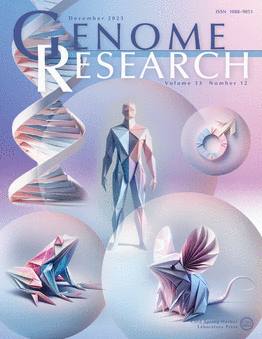Developmental transcriptomics in Pristionchus reveals the environmental responsiveness of a plasticity gene-regulatory network
IF 5.5
2区 生物学
Q1 BIOCHEMISTRY & MOLECULAR BIOLOGY
引用次数: 0
Abstract
Developmental plasticity enables the production of alternative phenotypes in response to different environmental conditions. Although significant advances in understanding the ecological and evolutionary implications of plasticity have been made, understanding its genetic basis has lagged. However, a decade of genetic screens in the model nematode Pristionchus pacificus has culminated in the identification of more than 30 genes that affect mouth form. We also recently reported the critical window of environmental sensitivity and therefore have clear expectations for when differential gene expression should matter. Here, we collated existing data into a gene-regulatory network (GRN) and performed developmental transcriptomics across different environmental conditions, genetic backgrounds, and mutants to assess the regulatory logic of mouth-form plasticity. We find that only two genes in the GRN (eud-1 and seud-1/sult-1) are sensitive to the environment during the critical window. The time points of their sensitivity differ, suggesting that they act as sequential checkpoints. Additionally, seud-1/sult-1 is differentially expressed across strains and species with different mouth-form biases, highlighting the potential role of switch-gene regulation in the evolution of plasticity. We also observe temporal constraint upon the transcriptional effects of mutating the GRN and reveal unexpected feedback between mouth-form genes. Finally, a comprehensive analysis of all samples identifies metabolism as a shared pathway for regulating mouth-form plasticity. These data are presented in a Shiny app to facilitate gene expression comparisons across development in up to 14 different conditions. Collectively, our results divide the GRN for mouth-form plasticity into environmentally sensitive switch genes and downstream genes that execute the decision.发育转录组学揭示了一个可塑性基因调控网络的环境响应性
发育可塑性使不同的环境条件下产生不同的表型。尽管在理解可塑性的生态和进化意义方面取得了重大进展,但对其遗传基础的理解却滞后了。然而,对模式线虫太平洋竖孔线虫进行了十年的基因筛选,最终鉴定出了30多个影响口型的基因。我们最近也报道了环境敏感性的关键窗口,因此对差异基因表达何时起作用有了明确的期望。在这里,我们将现有数据整理成一个基因调控网络(GRN),并在不同的环境条件、遗传背景和突变体中进行发育转录组学研究,以评估口腔形状可塑性的调控逻辑。我们发现GRN中只有两个基因(eud-1和seud-1/sult-1)在关键窗口期间对环境敏感。它们的灵敏度的时间点不同,表明它们充当连续的检查点。此外,seud-1/sult-1在不同口型偏向的菌株和物种中表达差异,突出了开关基因调控在可塑性进化中的潜在作用。我们还观察到GRN突变对转录效应的时间约束,并揭示了口型基因之间意想不到的反馈。最后,对所有样本进行综合分析,确定代谢是调节口腔形状可塑性的共同途径。这些数据呈现在Shiny的应用程序中,以方便在多达14种不同条件下进行基因表达比较。总的来说,我们的研究结果将口腔形状可塑性的GRN分为环境敏感的开关基因和执行决策的下游基因。
本文章由计算机程序翻译,如有差异,请以英文原文为准。
求助全文
约1分钟内获得全文
求助全文
来源期刊

Genome research
生物-生化与分子生物学
CiteScore
12.40
自引率
1.40%
发文量
140
审稿时长
6 months
期刊介绍:
Launched in 1995, Genome Research is an international, continuously published, peer-reviewed journal that focuses on research that provides novel insights into the genome biology of all organisms, including advances in genomic medicine.
Among the topics considered by the journal are genome structure and function, comparative genomics, molecular evolution, genome-scale quantitative and population genetics, proteomics, epigenomics, and systems biology. The journal also features exciting gene discoveries and reports of cutting-edge computational biology and high-throughput methodologies.
New data in these areas are published as research papers, or methods and resource reports that provide novel information on technologies or tools that will be of interest to a broad readership. Complete data sets are presented electronically on the journal''s web site where appropriate. The journal also provides Reviews, Perspectives, and Insight/Outlook articles, which present commentary on the latest advances published both here and elsewhere, placing such progress in its broader biological context.
 求助内容:
求助内容: 应助结果提醒方式:
应助结果提醒方式:


